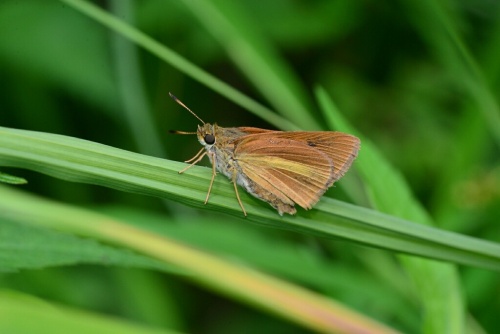Plants and Animals
Euphyes dukesi Dukes' skipper
Key Characteristics
The upper surfaces of the male are blackish brown with a black stigma on the forewing and faint orange scaling on the hindwing; the undersurface of the hindwing is yellowish brown with two yellowish streaks. The upper surface of the female is blackish brown with 1 to 3 small yellowish spots on the forewing and a faint orange streak on the hindwing; undersurfaces are similar to male's. The caterpillar is light green with a black head.
Status and Rank
US Status: No Status/Not Listed
State Status: T - Threatened (legally protected)
Global Rank: G3G4 - Rank is uncertain, ranging from vulnerable to apparently secure
State Rank: S2 - Imperiled
Occurrences
| County | Number of Occurrences | Year Last Observed |
|---|---|---|
| Hillsdale | 2 | 2025 |
| Jackson | 1 | 2007 |
| Lenawee | 1 | 2004 |
| Monroe | 7 | 2007 |
| Washtenaw | 4 | 2005 |
| Wayne | 5 | 2024 |
Information is summarized from MNFI's database of rare species and community occurrences. Data may not reflect true distribution since much of the state has not been thoroughly surveyed.
Habitat
Forested swamps and brushy wetlands with sedges. Shady freshwater swamps and roadside ditches. The species also inhabits small openings with dappled sunlight in dense stands of Carex lacustris and buttonbush wetlands. Adults nectar on buttonbush, swamp milkweed, and joe pye weed. Eggs are laid on wide-leaf sedge. Their major foodplants are sedges (Carex and Rhynchospora). In Michigan, the species' larval host plant is confined to wide-leafed sedge (Carex lacustris).
Specific Habitat Needs
Host plant needed in: Southern hardwood swamp; Southern wet meadow; Wet-mesic flatwoods.
Natural Community Types
For each species, lists of natural communities were derived from review of the nearly 6,500 element occurrences in the MNFI database, in addition to herbarium label data for some taxa. In most cases, at least one specimen record exists for each listed natural community. For certain taxa, especially poorly collected or extirpated species of prairie and savanna habitats, natural community lists were derived from inferences from collection sites and habitat preferences in immediately adjacent states (particularly Indiana and Illinois). Natural communities are not listed for those species documented only from altered or ruderal habitats in Michigan, especially for taxa that occur in a variety of habitats outside of the state.
Natural communities are not listed in order of frequency of occurrence, but are rather derived from the full set of natural communities, organized by Ecological Group. In many cases, the general habitat descriptions should provide greater clarity and direction to the surveyor. In future versions of the Rare Species Explorer, we hope to incorporate natural community fidelity ranks for each taxon.
Management Recommendations
Threats to this species include habitat loss, degradation and fragmentation due to conversion to agricultural lands; altered hydrologic regimes; altered fire regime; grazing and mowing patterns (i.e., vegetative succession); industrial, residential and/or recreational development; encroachment by shrubs and other woody species and invasive species; wetland modifications; and biological interactions such as decline of host plants. The use of pesticides and herbicides such as mosquito spraying also may pose a significant threat to the species. Surveys are needed to assess the status, abundance and distribution of this species in Michigan. Research to obtain more information about this species' life history and ecology and efforts to assess threats to this species in Michigan also are warranted. Protection of known populations, both the habitat and the skippers themselves, is critical in Michigan. This would include protection from physical destruction of the habitat as well as from mowing and spraying. In addition, sites should be managed to enhance the quality and extent of the habitat. This could include restoring natural hydrological conditions to previously disturbed areas and selecting restoration sites that connect existing, isolated populations with suitable habitat.
Active Period
Flight from first week of July to first week of August
Survey Methods
In Michigan, adults of this species have been documented from early July to early August (i.e., July 9 - August 1). The skipper flies low within sedges and is easily overlooked. They are rather slow flying. The best way to survey for this species is by conducting visual meander surveys which consists of checking for this species near larval food plants and on adult nectar sources such as button bush or swamp milkweed.
Visual, aerial net
Survey Period: From first week of July to first week of August
Time of Day: Daytime
Air Temperature: Above 60 degrees
References
Survey References
- Klots, A.B. 1951. Peterson Field Guides: Eastern Butterflies. Houghton Mifflin Company, Boston. 349pp.
- Martin, J.E.H. 1977. The Insects and Arachnids of Canada (Part 1): Collecting, preparing, and preserving insects, mites, and spiders. Publication 1643. Biosystematics Research Institute, Ottawa.
Technical References
- Evers, D.C. 1994. Endangered and Threatened Wildlife of Michigan. The University of Michigan Press, Ann Arbor. 412pp.
- Glassberg, J. 1999. Butterflies through Binoculars: The East. Oxford University Press, New York. 242pp.
- Nielsen, M.C. 1999. Michigan butterflies and skippers: A field guide and reference. Michigan State University Extension Bulletin E-2675, East Lansing. 248pp.
- Spieles, J.B., P.J. Comer, D.A. Albert, and M.A. Kost. 1999. Natural community abstract for prairie fen. Michigan Natural Features Inventory, Lansing, MI. 4 pp.
- Stehr, F. W. 1997. Michigan Lepidoptera Survey Sites and Seasonal Occurrence of Michigan's Listed Species Annual Report 1997. 30 pp.+ MI Lepidoptera Survey Data Collection Form
- Tepley, A. J., J.G. Cohen, and L. Huberty. 2004. Natural community abstract for southern floodplain forest. Michigan Natural Features Inventory, Lansing, MI. 14 pp.


